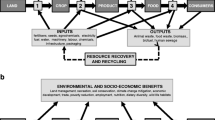Abstract
Although interdisciplinary collaboration to address a singleenvironmental problem is more common than in the past, all toooften the significant atmospheric problems of our day such asstratospheric ozone depletion, acidic deposition or climaticchange are addressed on a single issue basis. Systems analysis isa way of looking at a problem in a holistic, integrated fashionthrough including as many as practicable of the importantcomponents, and the linkages among them. Systems analysisoften begins with a conceptual model which, even if lackingquantification, is a useful means of changing one‘s thinking to amulti-issue approach. If possible, conceptual models are’operationalized‘ by quantification (using the best availablescientific knowledge) of the stocks and flows of the relevantcomponents of the problem, and the processes that are involved.In this paper, a systems approach to food production is used tolink various atmospheric issues such as regional acidification andclimatic change. A spreadsheet model of food demand andproduction in various world regions examined the possible effectof atmospheric change on how much food we can grow, andwhether or not we may be able to meet the increased demand inthe year 2025. Using relatively modest changes in factors ofagricultural production, the spreadsheet model calculated globalshortfalls by the year 2025 of the order of 10 to 20% in someimportant agricultural crops, despite the improvements in cropproduction factors that are envisaged by the Food andAgricultural Organization from now until the year 2010, and thatwere extrapolated in this paper to 2025. The model alsocalculated that climatic change in combination with eithertropospheric ozone or increased UV-B radiation caused bydepletion of the stratospheric ozone layer may in general makethe situation worse than in the case of climatic change alone.Given the large uncertainties in the input data, the results in thispaper should not be viewed as predictions but rather as anexample of taking a relatively simple systems approach to foodproduction using a spreadsheet model, and calculating the effectsthat various aspects of atmospheric change might have upon it.Therefore, it is extremely important to know the effects uponcrop production factors of climatic change, tropospheric ozoneand increased UV-B radiation not only as individual issues, butalso of their combined effect since it is probable that in manyregions they will occur in combination.
Similar content being viewed by others
References
Bartholomew, R. M., Shaw, R. W. and Leach, G.: 1994a, Food and Agriculture in POLESTAR: Part I: Technical description of the crop, biomass and livestock demand accounts. Working paper, Stockholm Environment Institute, Box 2142, S-103 14 Stockholm, Sweden, 114 pp.
Bartholomew, R. M., Shaw, R. W. and Leach, G.: 1994b, Food and Agriculture in POLESTAR: Part II: Technical description of the land resource, supply accounts. Working paper, Stockholm Environment Institute, Box 2142, S-103 14 Stockholm, Sweden, 76 pp.
Chameides, W. L., Kasibhatla, P. S., Yienger, J. and Levy, H. II: 1994, ‘Growth of Continental-Scale Metro-Agro-Plexes, Regional Ozone Production, and World Food Production’, Science 264, 74–77.
FAO: 1990, Agrostat: Agricultural Statistics Database. United Nations Food and Agricultural Organization, Rome.
FAO: 1993, Agriculture: Towards 2010. Report C93/24 submitted to the Twenty-seventh Session, United Nations Food and Agricultural Organization, Rome, 362 pp.
Hidy, G. M., Mahoney, J. R. and Goldsmith, B. J.: 1978, International aspects of the long range transport of air pollutants. Final Report, U.S. Dept of State, Washington, D.C.
IPCC, 1990: Scientific Assessment of Climate Change — Working Group 1. World Meteorological Organization, Geneva.
Krupa, S. V. and Kickert, R. N.: 1989, ‘The Greenhouse Effect: Impacts of Ultraviolet-B (UV-B) radiation, Carbon Dioxide (CO2), and Ozone (O3) on Vegetation’, Environ. Pollut. 61, 263–393.
Moffat, A. S.: 1992, ‘Does Global Change Threaten the World Food Supply?’ Science 256, 1140–1141.
Munn, R. E. (ed.): 1995, Atmospheric Change in Canada: Assessing the Whole as Well as the Parts. Workshop Report, Institute for Environmental Studies, University of Toronto, Toronto, Ontario, Canada M5S 1A4, 36 pp.
Parry, M.: 1990, Climate Change and World Agriculture. Earthscan Publications Limited, London, 157 pp.
Rotmans, J.: 1990, IMAGE: An Integrated Model to Assess the Greenhouse Effect. Kluwer Acadmic Publishers, Dordrecht, The Netherlands, 289 pp.
Shaw, R. W., Leach, G. and Bartholomew, R. M.,: 1994a, Feeding the World until 2050: A Conventional Development Scenario for Food, Agriculture and Land. Unpublished manuscript, Stockholm Environment Institute, Box 2142, S-103 14 Stockholm, Sweden, 35 pp. (available from R.W.S.).
Shaw, R. W., Leach, G. and Bartholomew, R. M.: 1994b, Feeding the World until 2050: Food, Agriculture and Land. Unpublished manuscript, Stockholm Environment Institute, Box 2142, S-103 14 Stockholm, Sweden, 14 pp. (available from R.W.S.).
Shaw, R. W. and Öberg, S.: 1994, ‘Sustainable Development: Applications of Systems Analysis’, The Science of the Total Environment 149, 193–214.
UN: 1992, Long-Range World Population Projections: Two Centuries of Population Growth, 1950–2150. United Nations Population Division, New York.
WRI: 1994, World Resources 1994–95: A Guide to the Global Environment. Oxford University Press, New York, 400 pp.
Author information
Authors and Affiliations
Rights and permissions
About this article
Cite this article
SHAW, R. linking various aspects of atmospheric change through a systems analysis of food. Environ Monit Assess 46, 113–133 (1997). https://doi.org/10.1023/A:1005796120699
Issue Date:
DOI: https://doi.org/10.1023/A:1005796120699




